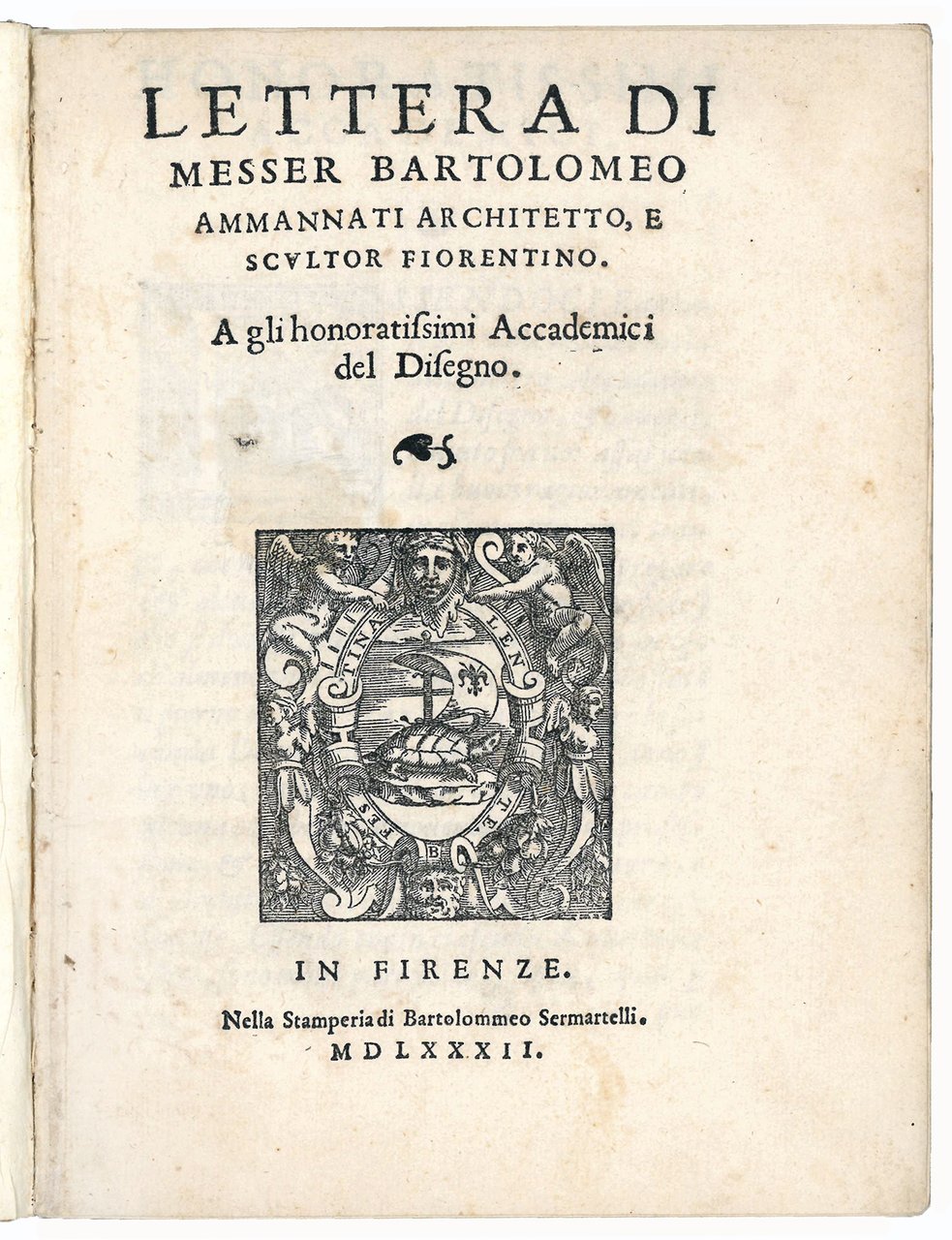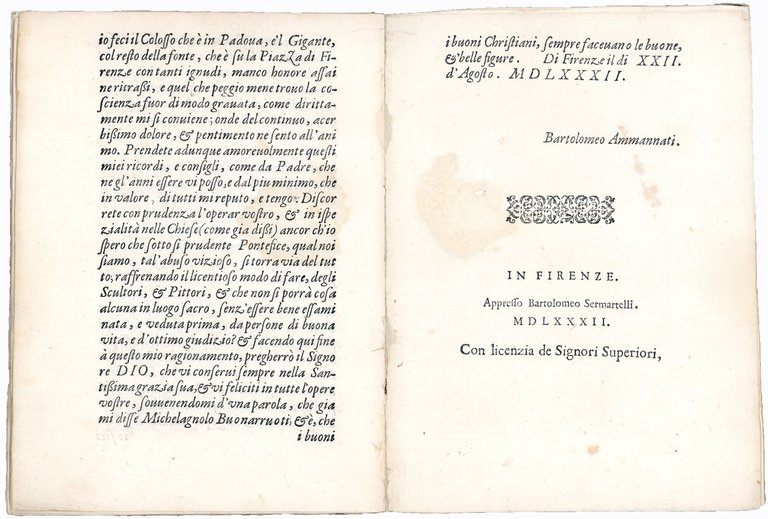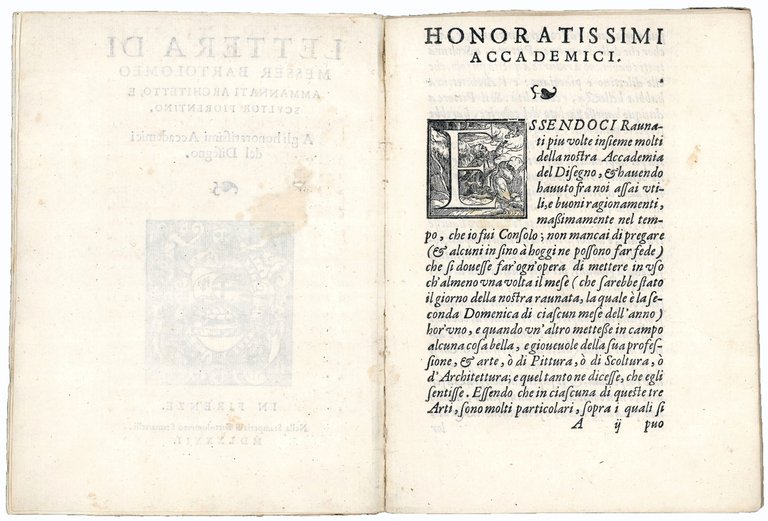



Libros antiguos y modernos
AMMANNATI, Bartolomeo (1511-1592)
Lettera di messer Bartolomeo Ammannati architetto, e scultor fiorentino. A gli honoratissimi Accademici del disegno
Bartolomeo Sermartelli, 1582
5800,00 €
Govi Libreria Antiquaria
(Modena, Italia)
Los gastos de envío correctos se calculan una vez añadida la dirección de envío durante la creación del pedido. El vendedor puede elegir uno o varios métodos de envío: standard, express, economy o in store pick-up.
Condiciones de envío de la Librería:
Para los productos con un precio superior a 300 euros, es posible solicitar un plan de pago a plazos al Maremagnum. El pago puede efectuarse con Carta del Docente, Carta della cultura giovani e del merito, Administración Pública.
Los plazos de entrega se estiman en función de los plazos de envío de la librería y del transportista. En caso de retención aduanera, pueden producirse retrasos en la entrega. Los posibles gastos de aduana corren a cargo del destinatario.
Pulsa para saber másFormas de Pago
- PayPal
- Tarjeta de crédito
- Transferencia Bancaria
-
-
Descubre cómo utilizar
tu Carta del Docente -
Descubre cómo utilizar
tu Carta della cultura giovani e del merito
Detalles
Descripción
4to (208x154 mm). [8] leaves. Collation: A-B4. Italic type. Woodcut printer's device on title page, woodcut initial. Modern carta rustica. Small stain around a repaired tiny hole going through each leaf. Bookplate of Giannalisa Feltrinelli (see sale Christie's London, 2 June 1998, lot 1091).
Rare first edition (it was reprinted in Florence in 1687) of Ammanati's famous letter to the Accademia del Disegno, the artist's guild at Florence, in which he denounced the display of nude sculpture, including his own colossal figure of Hercules in Padua and the Neptune fountain in the Piazza della Signoria in Florence.
One of the leading Mannerist sculptors and architects in Florence, Ammannati worked for Cosimo de' Medici on his programme of public works, remodelling Palazzo Pitti and the Boboli gardens, and building the Ponte Santa Trinita and the Neptune fountain in the Piazza della Signoria. Under the influence of the Counter-Reformation, however, at the end of his life Ammannati reconsidered his artistic expression and his art became more religious in tone. The present letter expressed his remorse at depicting nude bodies in his previous art, despite the importance of the shape of the body in his earlier work. As an example of virtuous sculpture from his last period, Ammannati cites in the letter the tomb of Giovanni Boncompagni, commissioned by Gregory XIII in 1572 for the cemetery of Pisa, which depicts Christ between Peace and Justice.
Although Ammannati doesn't mention it directly in the letter, this radical change may have been due to his advancing age and his new collaboration as patron and architect for the Jesuits, for whom he designed and financed the renovation of the church and college of San Giovannino. It was probably around 1572, thanks to the influence of his wife Laura Battiferri, that Ammannati began to be more involved in the activities of the Society of Jesus in Florence (cf. V. Kirkham, Creative Partners: The Marriage of Laura Battiferra and Bartolomeo Ammannati, in “Renaissance Quarterly”, LV, 2, 2002, pp. 498-558).
“When the first Jesuits arrived in Florence in 1551, they hoped to set up a community for twelve members of their order with the support of the Duchess Eleonora di Toledo. During the first few years, the Florentine Jesuits experienced many setbacks, and finding a permanent residence was one of their main concerns. For several years, they were forced to occupy a number of unsuitable, rented houses. They probably expressed their troubles to Eleonora, because in 1554 her husband, Duke Cosimo I de'Medici, donated the medieval church and the rectory of San Giovannino to them. The location was almost perfect: a central position, easily reached by students from all over town. However, the medieval building was too small and in a state of disrepair […] In Florence, due to the absence of a devoted and wealthy patron, no improvement of the accommodation of the Jesuit community was forthcoming. Almost fifteen years after establishing their foundation in Florence, the Jesuits still faced an insecure future. In 1566 a committee of supportive and prominent citizens was founded to find a solution, and it is likely that Ammannati soon became involved with their work […] Indeed, Ammannati's assistance proved to be of great value. His close involvement with the construction of the new complex was exceptional; Ammannati not only proposed to make the designs, he and his wife also offered to take care of a substantial part of the expenses. The couple had agreed to pay for the construction of the college as early as 1577, although Ammannati hoped to persuade Giacomo Salviati, the cousin of Francesco de' Medici, to be the main patron of the church. It seems that Salviati pulled back, making Ammannati responsible for bearing the cost of both the church and school. The best proof of Ammannati's and Battiferri's generosity was the decision of the childless couple in 1581 t

